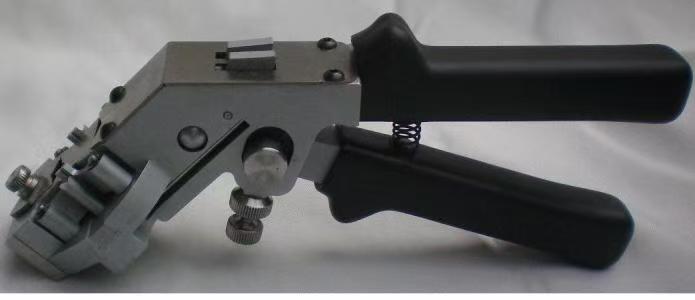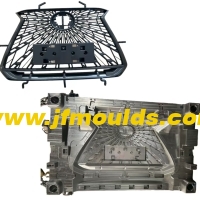Solutions to wire clamping, surface indentation and punch marks in molds
Solutions to wire clamping, surface indentation and punch marks in molds
The clamping wire of the mold
Phenomenon: There is obvious wire clamping at the product's welding area, and it is difficult to improve the situation by adjusting the machine.
Analysis: Due to the presence of holes in the product, there is wire jamming when the two strands of raw materials converge during the forming process. Moreover, this product is non-conductive under vacuum, and the electroplating coating cannot meet the customer's quality requirements. During the injection molding process, the end speed is too high and the mold temperature is too low.
Characteristics of injection molding machines
Grade: HT86T, Clamping force: 86t, plasticizing capacity: 119g
(2) Mold characteristics
Mold ejection number: 1×2, glue injection method: large water outlet, ejection method: Ejection with ejector pins, mold temperature: 100°C (constant temperature machine)
(3) Product characteristics
Material: ABS 727, product weight (single piece) : 0.98g, sprue weight: 1.04g
(4) Analysis of causes of defects
Due to the presence of holes, the product forms two streams of raw materials converging together. Before the raw materials are formed and the mold is opened, poor exhaust cannot completely expel the gas outside the mold, resulting in wire clamping.
(5) Countermeasures
1. Utilize multi-level injection and position switching.
2. In the first section, fill the runner to the glue inlet at a medium speed and find the corresponding switching position. In the second section, fill 85% of the mold cavity at a medium speed to prevent the high-temperature molten glue from cooling. In the third section, fill the mold cavity slowly to completely expel the air inside, allowing the molten material to flow slowly into the cold material area.
3. Add cold material at the wire clamping point to ensure that when the two strands of raw material combine during molding, they still flow outward without the wire clamping remaining on the product's surface.
4. Increase the surface temperature of the mold.
Auto Mould_Taizhou Jiefeng Mould Co.,Ltd. (jfmoulds.com)

The surface indentation of the mold
Phenomenon: Structural defect of the mold
Analysis: Poor exhaust; The product structure is complex.
Characteristics of injection molding machines
Grade: Haitian, Clamping force: 86t, Plasticizing capacity: 100g
(2) Mold characteristics
Mold ejection number: 1×2, injection method: lap gate, ejection method: Ejection by ejector pin, mold temperature: 80°C (constant temperature machine)
(3) Product characteristics
Material: ABS 727, Color: natural color, Product weight (single piece) : 2.4g, sprue weight: 4.3g
(4) Analysis of causes of defects
The product has a complex structure and poor exhaust
(5) Countermeasures
1. Increase the oil temperature appropriately
2. Insert pins at the rear die clamping mark to increase exhaust.
Commodity Mould_Taizhou Jiefeng Mould Co.,Ltd. (jfmoulds.com)
The punch marks on the mold
Phenomenon: There are obvious scratches on the cold material area of the product, and it is difficult to improve the situation by adjusting the machine.
Analysis: 1. To improve the problem of wire clamping at the product's welding point, after changing the glue entry from four points to two points, cold material was added near this area. During the forming process, when the two streams of material converge at this point, a punch mark occurs due to the cold material flowing inward.
2. The end speed is too high during the injection molding process.
Characteristics of injection molding machines
Grade: DEMAG100T, Clamping force: 100t, plasticizing capacity: 61g
(2) Mold characteristics
Mold ejection number: 1×1, glue injection method: large water outlet, ejection method: Ejection with ejector pins, mold temperature: 105°C (constant temperature machine)
(3) Product characteristics
Material: ABS+PC GE 1200HF-100, product weight (unit price) : 2.17g, nozzle weight: 3.81g
(4) Analysis of causes of defects
1. The product features two-point injection and is relatively thin. During the molding process, it requires greater pressure and a faster speed. When two streams of raw materials converge and flow into the cold material, burrs will occur.
2. The speed in the last section is too high.
(5) Countermeasures
1. Utilize multi-level injection and position switching.
2. In the first section, fill the runner to the rubber inlet at a relatively fast speed and find the corresponding switching position. In the second section, fill the area near the rubber inlet at a medium or small position. In the third section, fill 85% of the mold cavity at a slower speed to prevent the high-temperature molten rubber from cooling down. In the fourth section, fill the mold cavity slowly to completely expel the air inside the cavity, allowing the molten material to flow slowly into the cold material area to avoid the formation of burrs. Finally, switch to the pressure-holding switching position.
3. Shorten the cold material at the wire clamping point.
Related News
The selection of mold base specifications and models
2025-09-28
The selection of mold base specifications and models(1) Selection of two-plate m...
The solution to the problem of the lens length dimension of the mold being too large and the water line being clamped on the side of the middle hole position
2025-08-11
The solution to the problem of the lens length dimension of the mold being too l...
The new business card of "Mold Capital" is fully started.
2025-06-19
Recently, at the construction site of the Huangyan Mould Intelligent Manufacturi...
Solutions for mold clamping lines, surface clamping marks and clamping position sticking to the mold
2025-08-15
Solutions for mold clamping lines, surface clamping marks and clamping position ...
The coordinated evolution of technological iteration and industrial ecosystem
2025-07-15
The coordinated evolution of technological iteration and industrial ecosystemI. ...
Solutions to wire clamping, surface indentation and punch marks in molds
2025-08-14
Solutions to wire clamping, surface indentation and punch marks in moldsThe clam...





